Rare and elusive bush dog caught on camera in Panama
Loading...
Bush dogs – one of the world’s most mysterious species – have been caught on camera in Panama.
Not much larger than a house cat, bush dogs are an elusive canid species that live throughout South America. Typically running through tropical forests in packs up to 10, bush dogs mainly eat rodents.
Despite their broad habitat from Panama to Paraguay, bush dogs (Speothos venaticus) are rarely seen by humans.
“The bush dog is one of the rarest species that we photograph,” said Smithsonian Research Associate Ricardo Moreno, the study’s co-author. The authors set up camera traps to survey other, larger mammals such as jaguars, but the bush dog snapshots came as a pleasant surprise.
“To give some idea of the difficulty of studying the species, photos were obtained on only 11 occasions out of more than almost 32,000 camera-days,” the Smithsonian Tropical Research Institute said in a statement.
In fact, most of what is known about the behavior and physical characteristics of bush dogs is gleaned by studying captive populations.
But the elusiveness of bush dogs is making it difficult for scientists to protect the species from population decline.
Unlike other Panamanian carnivores like jaguars and pumas, bush dogs are not directly persecuted by humans. But the small, wild dogs are still experiencing serious population decline from habitat loss. Between 1990 and 2000, 15 percent of Panama’s forests have cut down. Other threats include loss of prey from hunting by humans and potential diseases carried by domestic dogs in the area.
The International Union for Conservation of Nature (IUCN), a globally respected database for the population status of the worlds’ species, has the bush dog listed as “near threatened.” As the level listed just after the category of “least concern,” “near threatened” essentially evaluates the bush dog population as viable.
The IUCN estimates a 20 to 25 percent decline in the bush dog population in the past 12 years. So in its evaluation of the bush dog, IUCN recognizes that the bush dog is approaching a “vulnerable” status.
But because they are so elusive, the researchers behind the article say the bush dog should be listed as ‘Endangered’ even if the ICUN doesn’t have the population data to support the status change.
“The limited amount of data does not allow us to determine reliably or compare bush dog density with other regions and other biomes, nor estimate their population size,” the authors write in their study. “However, the very low detection rate of bush dog despite numerous surveys undertaken across the country for ten years substantiates their rarity in the isthmus.”








